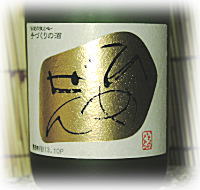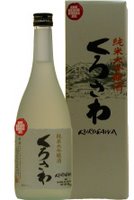July 27, 2006
 My favorite izakaya, Sakagura, hosted yet another saké dinner, this time under the theme of Sakés for Summer as selected by their kimono-clad Saké Sommelier, Chizuko Niikawa.
My favorite izakaya, Sakagura, hosted yet another saké dinner, this time under the theme of Sakés for Summer as selected by their kimono-clad Saké Sommelier, Chizuko Niikawa.The first selection was a German Riesling-like low alcohol saké, Ichinokura Himezen (SMV: -65, Acidity: 5, Rice: Toyonishiki, Seimaibuai: 65%, Yeast: N/A).
 I often refer to this as umeshu-light, as it has the tinge of Japanese plum flavor and balanced sweet/tart profile. Chizuko-san said that this would be the perfect saké to quench your thirst, and build appetite before dinner.
I often refer to this as umeshu-light, as it has the tinge of Japanese plum flavor and balanced sweet/tart profile. Chizuko-san said that this would be the perfect saké to quench your thirst, and build appetite before dinner.The second selection was appropriately enough, Summer-release namazaké from Umenishiki Brewery of Ehime Prefecture (SMV: +4, Acidity: 1.2, other data N/A). This happened to be a super premium Junmai Daiginjo grade, and had a very expressive notes of pineapples and lychee, with a refreshing crispness and dryness.
 Just for good measure, the next selection was also Junmai Daiginjo, but not of the Summer-release unpasteurized style. We got to try Otokoyama Junmai Daiginjo (SMV: +5, Acidity: 1.3, Rice: Yamadanishiki, Seimaibuai: 38%, Yeast: N/A)from the northern island of Hokkaido. While there were elements of fruit, notably pineapple, on the palate, it also had the balanced grain with clean and dry finish that has been the hallmark of their seishu.
Just for good measure, the next selection was also Junmai Daiginjo, but not of the Summer-release unpasteurized style. We got to try Otokoyama Junmai Daiginjo (SMV: +5, Acidity: 1.3, Rice: Yamadanishiki, Seimaibuai: 38%, Yeast: N/A)from the northern island of Hokkaido. While there were elements of fruit, notably pineapple, on the palate, it also had the balanced grain with clean and dry finish that has been the hallmark of their seishu.The decent from pinnacle of Junmai Daiginjo was gentle. It started with Koshi No Kanbai "Kinmuku" Junmai Ginjo (SMV: N/A, Acidity: N/A, Rice: Yamadanishiki, Seimaibuai: 45%, Yeast: N/A)from Niigata Prefecture. Mildl fruity, grainy, and dry, it was the perfect progression from Otokoyama.
The progression continued with surprise addition, Momokawa Tokubetsu Junmai (SMV: +2, Acidity: 1.4, Rice: N/A, Seimaibuai: 60%, Yeast: N/A) from Aomori Prefecture. Served in an iron pot, I was expecting a warm saké, but that turned out to be an illusion. After Junmai Ginjo, this went down even more like water, although I did detect hints of fruit and grain as well.
 The dessert was served with Hanahato (Japanese only) Kijoshu (SMV: -44, Acidity: 3.5, Rice: Chouseishinsenbon, Seimaibuai: 65%, Yeast: Assoc. #9). To qualify as Kijoshu, the water is replaced with Junmaishu prior to bottling and aging (8 years in this case), so this step is very similar to Port or Sherry. Like Port, the flavor contains nuts, dried fruits, raisin, dark chocolate with a long finish. Another perfect way to end a perfect evening...
The dessert was served with Hanahato (Japanese only) Kijoshu (SMV: -44, Acidity: 3.5, Rice: Chouseishinsenbon, Seimaibuai: 65%, Yeast: Assoc. #9). To qualify as Kijoshu, the water is replaced with Junmaishu prior to bottling and aging (8 years in this case), so this step is very similar to Port or Sherry. Like Port, the flavor contains nuts, dried fruits, raisin, dark chocolate with a long finish. Another perfect way to end a perfect evening...************************************************************
August 8, 2006
 On this day, we had what can be described as Saké Summit II. Since Sakurai-san was in town, we decided to have a BYOS party at my friend Hideo's place on UES. In attendance were Saké Buddies Hideo, Tim Sullivan, Lefty, Warren, Sakurai-san, and Nogami-san. Thanks to Tim for sharing the pictures, as usual. Without further ado, here are the selections:
On this day, we had what can be described as Saké Summit II. Since Sakurai-san was in town, we decided to have a BYOS party at my friend Hideo's place on UES. In attendance were Saké Buddies Hideo, Tim Sullivan, Lefty, Warren, Sakurai-san, and Nogami-san. Thanks to Tim for sharing the pictures, as usual. Without further ado, here are the selections: Saké #1: We started with a Kimoto Honjozo (SMV: +1, Acidity: 1.4, Rice: Gohyakumangoku, Seimaibuai: N/A, Yeast: N/A) by Daishichi Brewery of the Minowamon fame. This is a good starter, as it is refreshing style with balance of fruit, grain, and dryness.
Saké #1: We started with a Kimoto Honjozo (SMV: +1, Acidity: 1.4, Rice: Gohyakumangoku, Seimaibuai: N/A, Yeast: N/A) by Daishichi Brewery of the Minowamon fame. This is a good starter, as it is refreshing style with balance of fruit, grain, and dryness.Saké #2: was the ever-so-reliable Masumi Okuden (SMV: +3, Acidity: 1.5, Rice: 80% Miyamanishiki/ 20% Hitogokochi, Seimaibuai: 60%, Yeast: Assoc. #7), where you can find my notes about half way down this page.
 Saké #3: Otokoyama "Momenya" Tokubetsu Junmai (SMV: N/A, Acidity: N/A, Rice: N/A, Seimaibuai: 55%, Yeast (N/A). Warren was very intrigued by this version of the Otokoyama, so this was his contribution. This saké was very interesting, offering heavy contrast to the elegant Masumi. More expressive with hints of banana, the flavor seems to intensify and firm towards the finish, reminiscent of a Genshu.
Saké #3: Otokoyama "Momenya" Tokubetsu Junmai (SMV: N/A, Acidity: N/A, Rice: N/A, Seimaibuai: 55%, Yeast (N/A). Warren was very intrigued by this version of the Otokoyama, so this was his contribution. This saké was very interesting, offering heavy contrast to the elegant Masumi. More expressive with hints of banana, the flavor seems to intensify and firm towards the finish, reminiscent of a Genshu.Saké #4: Aiyu "Tomoju" Junmai Ginjo (SMV: +2, Acidity 1.5, Rice: Gohyakumangoku, Seimaibuai: 50%, Yeast: N/A), selection by Lefty. As some may recall, I have a pretty high regards for this saké. Incidentally, I have received email from Mr. Kanehira, EVP of the brewery, that Tomoju received a Gold Medal in their category. In other words, a good choice all around!
 Saké #5: Kurosawa Junmai Daiginjo (SMV: 0, Acidity: N/A, Rice: N/A, Seimaibuai: 40%, Yeast: N/A). Synonymous with Nagano saké, Kurosawa has a very distinct style that shows up in their limited production (1,500 bottles/year) Junmai Daiginjo. While a lot of Dainginjo-grades showcases fruit, Kurosawa has great balance of ginger, hibiscus, cedar, herbs, spices, and umami. Just an unique and incredible style like no other.
Saké #5: Kurosawa Junmai Daiginjo (SMV: 0, Acidity: N/A, Rice: N/A, Seimaibuai: 40%, Yeast: N/A). Synonymous with Nagano saké, Kurosawa has a very distinct style that shows up in their limited production (1,500 bottles/year) Junmai Daiginjo. While a lot of Dainginjo-grades showcases fruit, Kurosawa has great balance of ginger, hibiscus, cedar, herbs, spices, and umami. Just an unique and incredible style like no other. Saké #6, 7, 8: Trifecta of Dassai. Mr. Sakurai brought 3 small bottles of Dassai for us to taste. Let's just say that there weren't enough! In the past, I have heaped praise upon praise on their Junmai Daiginjo and Junmai Ginjo, so now, I'll take time to provide notes on their Junmai Ginjo Nigori (SMV: +6, Acidity: 1.2, Rice: Yamadanishiki, Seimaibuai: 50%, Yeast: N/A). Staying with their stringent standard, this Nigori is polished down to 50%. The result is a very fragrant, light, and crisp style with fruity flavors and amami that leads to a dry finish. The amount of lees is mild, providing a nice texture without being overwhelming.
Saké #6, 7, 8: Trifecta of Dassai. Mr. Sakurai brought 3 small bottles of Dassai for us to taste. Let's just say that there weren't enough! In the past, I have heaped praise upon praise on their Junmai Daiginjo and Junmai Ginjo, so now, I'll take time to provide notes on their Junmai Ginjo Nigori (SMV: +6, Acidity: 1.2, Rice: Yamadanishiki, Seimaibuai: 50%, Yeast: N/A). Staying with their stringent standard, this Nigori is polished down to 50%. The result is a very fragrant, light, and crisp style with fruity flavors and amami that leads to a dry finish. The amount of lees is mild, providing a nice texture without being overwhelming. Saké #9: Senkin "Ginyu Shizuku" Junmai Daiginjo (SMV: +5, Acidity: 1.3, Rice: Yamadanishiki, Seimaibuai: N/A, Yeast: Tochigi Yeast). This was Tim's selection, a free-run style saké from Tochigi Prefecture. After having 8 (?!) high-quality sakés of varying styles, what better way to end the tasting than with a fruity, rich, and soft style Junmai Daiginjo? The flavors of melon and pineapple was perfect, almost like dessert, and the gentle mouthfeel is exactly what was needed at that point. Only thing that could be better is for that Chinese food to arrive...
Saké #9: Senkin "Ginyu Shizuku" Junmai Daiginjo (SMV: +5, Acidity: 1.3, Rice: Yamadanishiki, Seimaibuai: N/A, Yeast: Tochigi Yeast). This was Tim's selection, a free-run style saké from Tochigi Prefecture. After having 8 (?!) high-quality sakés of varying styles, what better way to end the tasting than with a fruity, rich, and soft style Junmai Daiginjo? The flavors of melon and pineapple was perfect, almost like dessert, and the gentle mouthfeel is exactly what was needed at that point. Only thing that could be better is for that Chinese food to arrive...

No comments:
Post a Comment